The world citizen
Okwui Enwezor, Curator
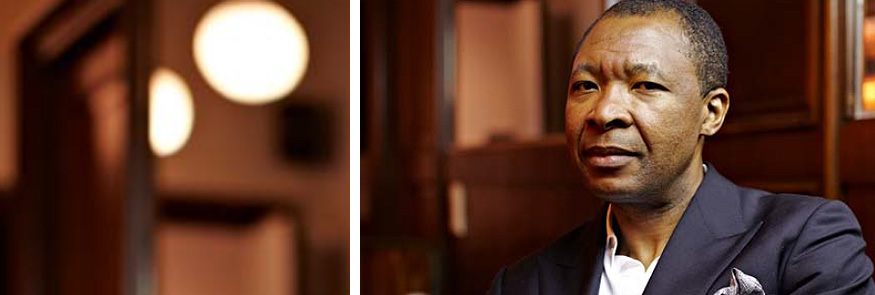
1
“Surfers, yes, the surfers! They are always in motion.”
He ranks among the thought leaders on international contemporary art – and is an entertaining conversationalist. Okwui Enwezor, born in Nigeria in 1963, sits in the Goldene Bar in Munich’s Haus der Kunst, where he has just taken on the post of Director. In the best of moods, he chats about the surfers who perform their tricks on the Eisbach River, which rushes through the park behind his museum. We are joined for a moment by his predecessor, Chris Dercon, who is moving to Tate Modern in London. As Artistic Director of the 2002 documenta, Enwezor opened the eyes of the world to the contemporary art of Africa. This is the man who called the Western- and white-dominated scene of art museums, exhibits and galleries into question and has opened its doors to other continents and cultural circles. In the surfers, he sees a beautiful metaphor for the art world – “Yes, the surfers! They are always in motion.”
The Focus: Unlike many curators, you have looked beyond the narrow confines of a Western and more Western-oriented understanding of art to embrace a transnational, transcultural perspective. You have challenged the widely-held views of curators, artists and critics – the views of a whole system – on contemporary art. This is all the more astonishing because your degree is not in art, but…
Okwui Enwezor: …yes, political science and literature. Well, it is always very difficult to draw a precise line, to tell when the Eureka moment occurred and everything cohered; but at some point I knew that I wanted to be in art. One of the first things I must underscore is that I wanted to go to New York, not to New Jersey, not to Pennsylvania. I wanted to go to New York, a place full of vitality that has what one could consider a pluralistic cultural outlook.
The Focus: And did the city live up to your expectations?
Enwezor: To a certain extent. But it also surprised me that the cultural spaces were not as cosmopolitan as I had imagined them to be. The first exhibition that really impressed me was held by the Museum of Modern Art, “ ‘Primitivism’ in 20th Century Art: Affinity of the Tribal and the Modern.” When I saw the exhibition I had already been in New York for roughly two and a half years, and I loved it. I was intrigued by the fact that you can have this intersection between what was called “primitive art” and “modern art.” It was only a few months later that I learned that I was not supposed to like the exhibition. I still loved it, however – to this day, I think of that exhibition as a benchmark.
The Focus: Why weren’t you supposed to like it?
Enwezor: There was a huge debate in the pages of art journals about the condescending nature of the exhibition, the relationship between objects and artists. Western artists had names, they had identity and subjectivity. In contrast, the African art was objects with no identity; it was tribes. So that show awakened something very important in terms of the dialectic – this question of the West and the non-West.
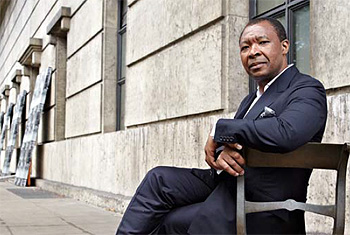
The Focus: Were you in contact with art while you were still in Africa?
Enwezor: It is important to clarify what we mean when we talk about art. Because art is not what happens in museums. Growing up in Nigeria, “art” and “contemporary art” were completely different things. Had I been in contact with contemporary art in Nigeria? Yes – I had friends who were artists. And you can’t be in Nigeria without being in contact with art every single day, because you have lots of cultural and artistic festivals. I think we really need to start unlearning the notion of confining the arts to particular institutional spheres. Art was part of the everyday, something I participated in myself as a young child, in a number of social rituals or coming-of-age moments that my parents insisted I go through because they are a part of our tradition.
The Focus: What kind of tradition?
Enwezor: Where I come from, my family has lived there continuously for at least one thousand years. And this results in a dense accumulation of cultural traditions and artistic objects. But in terms of how the discourse of contemporary art is framed, contemporary art is a completely different thing. That was why “ ‘Primitivism’ in 20th Century African Art” was very important, because it opened up an avenue of discourse that I didn’t know what to do with then, but which crystallized a few years later. I was fortunate to be in New York at a time when the critical systems of contemporary art were about to be reformulated.
The Focus: And you decided to be part of this process of reframing by becoming a curator?
Enwezor: You know the famous opening sentence by Ernst Gombrich in his book The Story of Art: “There is no art. There are only artists.” On the other hand, primitivism said to us: “There is only African art but there are no African artists.” And really, this became my interest because I also had to consider my own contemporary framework. Because there were no African artists and it seemed there could be no African writers or African thinkers. I had to ask myself why that was.
The Focus: That led you to found the magazine Nka.
Enwezor: In the late 1980s, I was part of a group of “non-white” critics, writers and artists that focused on the question of why institutions did not mentor or encourage young African or African-American curators. Why was there no access for them? Why did the art world, which always considered itself very liberal, operate in a strictly closed system? We wanted to challenge that.
The Focus: So your interest was not only in becoming a curator…
Enwezor: …it was also in cultural politics and the politics of representation, the politics of translation. We were saying that we cannot always ask for admittance – we have to create structures through which we can then admit the discourse. That’s why I started the magazine.
The Focus: In a way, did it help that you hadn’t enjoyed a classical education as an art historian? Did this enhance your critical view of the power structures of the art world?
Enwezor: Very few curators actually have a specific background in art history. I think this is something that we really have to emphasize, because curating is a new discipline, a language that has been created by people who make exhibitions.
And really, how do you historicize the different methodological, conceptual and philosophical aspects of curating? Look at people like Harald Szeemann or Kasper König – none of these people are art historians. To me, criticism and writing about art was a way not only to understand its internal mechanisms but also to underscore the richness of imagination that can’t fully be assessed through historical methods.
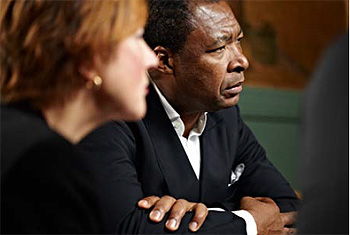
The Focus: During your early years, was there a major change in the art world that impacted your career?
Enwezor: Until the sixties, we associated the construction of contemporary art with movements and with cities. Paris was an inner center, with a later shift to New York. But this started to change by the end of the 1980s, with the biennale art exhibitions emerging in the role that cities once held. In the nineties I was a member of an emerging generation of curators in our early thirties. I had the great privilege to actually direct a biennale myself, and that was an enormous boost to my confidence.
The Focus: What was your reaction when you were invited to curate the documenta?
Enwezor: That is actually a very funny story, because I didn’t know whether accepting the invitation to be a candidate was the right thing for me to do. So I didn’t actually submit my application until the day before the deadline. I thought about it for almost a month.
The Focus: What were your doubts?
Enwezor: That is a very good question. First and foremost I asked myself: Would the kind of project I wanted to offer really be meaningful in this particular context? Because you know that the documenta is very large – it’s almost mythical.
The Focus: And not new.
Enwezor: Well, yes, not new, and they see the director as a kind of impresario. And the people who had curated it in the past were much older. They had deeper connections with the European and American art world – with the exception of Catherine David, whom I already knew since I had been to her documenta. But I was really skeptical about whether the documenta or the jury would accept the move to what I called a “third era” of documenta. And to be honest, I also asked myself if I was strong enough to withstand the pressure. After all, I was only 34.
The Focus: What was your vision? What did you want to achieve through the documenta?
Enwezor: On the one hand, I wanted to address the exploded, off-center universe of contemporary art; the emergence of the global sphere over the national sphere as a place of conversation. I also wanted to off-center and de-ritualize the documenta, to move it from its foundation in Kassel and put the documenta in the world, not have the world come to the documenta.
The Focus: Which were, of course, high aspirations.
Enwezor: For me the documenta has always been more than simply an exhibition – it is a meaning-making machine. I think our approach to renewing the documenta was similar to the way in which curatorial praxis was moving towards discourses as they emerged. The discourses themselves were not peripheral to the exhibition but integral to understanding the logic of the curatorial methodology. What we wanted to do with the documenta was not just simply work in secret and then raise the curtain like a magician – we wanted to do what we call “transparent research,” which is to say our intentions had to be apparent from the outset. Our goal was to turn the run-up to the exhibition into part of the exhibition.
The Focus: It was interactive, in a sense?
Enwezor: Yes. The first platform of the documenta was held in Vienna from January to April 2001, the aim being to collaborate with other institutions across different cities. This really was a curatorial experiment, not only to test the limits of what the exhibition was capable of absorbing but also to work with what I call “epic time.” What if we stress the time of the work and really work with the logic of temporality as such? So we showed films like Ulrike Ottinger’s, which is about eight hours long. I remember a discussion I had with Ulrike. Her film was much longer, and we went back and forth, you know – “Isn’t it possible to shorten it?” – “I can’t make it shorter! It has to be eight hours.”
Similarly, we’d had a Darboven; art of this kind is really not just about the scale of the work, but also the density of the temporal structure in which the work is embedded.
The Focus: Looking back, do you think you’ve changed things in a lasting way with your documenta? What is now better or different?
Enwezor: I think it would be incredibly presumptuous of me to draw that sort of conclusion. But I will say that my colleagues and the public have generously acknowledged the ideas that my documenta put forward. And I must underscore that my documenta was not the work of a single author. It was the result of multiple authors coming together to rethink the place of the artistic work and the predominant constructs of exhibition making.
The Focus: But would you say you achieved a greater inclusion of non-Western artists?
Enwezor: Well, going by the numbers, yes. I made it clear when I took the job – in my documenta, I wanted to double the number of non-Western artists compared to all the past documentas. But the inclusiveness was not just a question of numbers, but of discourses as well. Accordingly, in 2001 we already began with our first platform in Vienna, called “Democracy Unrealized.” The second platform was called “Experiments with Truth”; it dealt with the transition of justice and the process of brutal reconciliation, really rethinking the post-war reorganization of the global order. A third platform, held in St. Lucia, was more closed – by invitation, so not really open to the public. It was called “Créolité and Creolization” and dealt with questions of language and mixture, of hybridization.
The Focus: You invited people from Asia, Europe, Latin America, the United States and Africa.
Enwezor: Yes. And the fourth platform was held in Lagos. It was called “Under Siege: Four African Cities.” We wanted to look at the evolving discourse of urban subjectivity, the way in which notions of cosmopolitanism played out in the context of encounters and conflicts. The fifth platform was the exhibition itself, where all of these things coalesced.
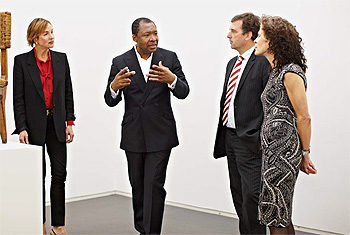
The Focus: You described the different platforms as open research. Research very often leads to surprises. What kind of surprises did you encounter?
Enwezor: A lot of things did not really become immediately obvious. Let me give you one example: If you had been in New Delhi in May 2001, you could have sworn that this was a discussion about 9/11. The hostility of the public to the United States was incredible. It reminded me of that famous reply by Gandhi when he was being interviewed by a British journalist. He was asked, “What do you think of Western civilization?” And Gandhi replied, “I think it would be a good idea.” During our discussions in New Delhi, there was the shadow of terrorism. Some activists in India were protesting against the Indian government’s suppression of an independence movement by a minority in a part of India. They came into the hall and opened their banner in the midst of the conference. I was so shocked: How did they hear about the conference? So there were many surprises that emerged.
The Focus: Did you discover any new artists through these platforms?
Enwezor: Without these conferences I would never have met Amar Kanwar or many other artists. Yang Fudong and all the young artists we met through our travels are now important figures in contemporary art.
The Focus: Ten years later, what is your opinion of the contemporary art scene from a global viewpoint? How far have we come and what major challenges await us?
Enwezor: It seems to me that it has really been exploded and I believe that we are currently reassessing the exploded nature – the commodification – of contemporary art. You know that art has always been commodified. I think we need to rediscover Pierre Bourdieu’s notion of distinctions – are we capable of seeing distinctions that are not exclusive or a retreat into hermeticism? I think the challenge is maintaining a balance between many people adopting art as lifestyle and the necessity of meaning-making – a challenge created by the huge infusion of capital into the art world at present.
The Focus: Like at the big Damien Hearst auctions?
Enwezor: I’m not going to mention any names.
The Focus: You once said that “everything is art – there are no boundaries between design, lifestyle and ‘proper’ art.” Again, you try not to make a distinction here, but instead draw a line between what opens minds or new frontiers and everything else…
Enwezor: Yes, absolutely.
The Focus: But who is to judge? The curator?
Enwezor: Well, it is not up to the curator to draw immediate conclusions. The difference between the market and the museum is temporal. Institutions are slower, the market is faster – but obviously we cannot ignore the fact that the field of art is a complex ecology. I think galleries do immensely important work for us; I am not one of those curators that see galleries as the opposition. Look at any catalog from the 1980s or maybe just open an art magazine from that period and look at the advertisements. You’ll be shocked at how many artists’ names you don’t recognize. It is clear that there is a system of selectivity that occurs. But it takes time for us to really look back and see where the waters have parted, with people left behind and people moving forward to other realms.
The Focus: What else do you observe?
Enwezor: I am really excited by the fact that contemporary art has continued to open to the rest of the world – in the Middle East, in China, in India, in Africa. It is a huge challenge for the curator to make an assessment of all of this, especially if you are not well informed about these regions. This is a challenge for museums and institutions.
The Focus: What is happening to the traditional temples of the arts? They seem to be increasingly dominated by big private collectors.
Enwezor: Yes, but I think we have always displayed the treasures of influential people. This is really nothing new.
The Focus: They’ve always had their palazzi?
Enwezor: Yes, and we have always displayed their treasures, whether it is the treasures of dead kings or the treasures of the current moguls who rule the world. Museums are not natural things that simply emerge out of nature – museums are human constructs. They come out of the taste-making systems of individuals, and when we curate objects in them and put those objects in perspective, they become the highest aspirations of our cultural imagination.
The Focus: There once was the utopian idea of a public museum representing democracy, free of the moguls’ influence.
Enwezor: But what is the world of the public museum as opposed to the private museum? The Guggenheim, you know, was created out of a private collection, and today is accepted as one of the most important public museums in the world. It is important to look at the civic role of the collectors.
The Focus: The “Skin Fruit” exhibition in the New Museum in New York, curated by Jeff Koons from works owned by private collector Dakis Joannou, was a disaster.
Enwezor: Dakis Joannou has supported artists enormously. If you look at what Pinault is doing in Venice, yes, you can question some of the curatorial decisions. But nevertheless, all of these activities really contribute to the greater expansion of contemporary art. Venice obviously is a city of patronage and collectors, who made all those frescoes, paintings and altarpieces possible.
The Focus: From all these global spaces, you have moved to Bavaria. How do you plan to make your personal mark here?
Enwezor: It’s a slow process. I am only just beginning to dip my toes into the water, to really understand the context, understand the building, and develop a strong rapport with my colleagues in the institution to create an environment where we can work together. Haus der Kunst has to be a place where you come not to see only exhibitions; as a public venue it must engage in questions of culture and discussion.
The Focus: You have a clear understanding of how to reframe the context of art between being an economic factor and being a cultural-political factor. To what extent are you seen as a challenger of the system?
Enwezor: I think it would be very far-fetched to see me as a challenger. I think there are already new generations rising – if anything, the challenge I face is the fact that I am part of the status quo. I really see part of my role here as providing a foundation for younger curators and other people to build on.
The Focus: For the documenta you were the main driver of content, and now you are creating another platform.
Enwezor: Precisely.
The Focus: Haus der Kunst is in some ways a strange building with a difficult past – built by the Nazis and later claimed by the in-crowd, which spent its nights partying downstairs in the famous P1 nightclub. What intrigues you about Haus der Kunst as a building?
Enwezor: The building itself is magnificent. The galleries are beautiful. Some of the spaces are monumental, which makes them a challenge to work with. In terms of scale, however, they are absolutely, indisputably, a place for contemporary art. It’s a place that might look serious but is in fact fun. It doesn’t quite fit into its surroundings – it sits in this weird in-between space, in this epicenter of Munich’s English Garden. It has no natural neighbors except the Eisbach surfers – yes, the surfers! But they are always in motion.
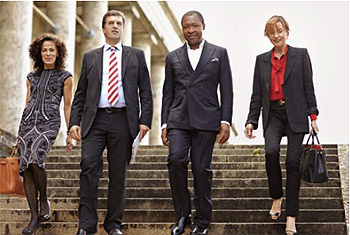
Talking with Okwui Enwezor in Munich were (from left) Ulrike Mertens, Friedrich Kuhn and Birgit Beckmann from Egon Zehnder.
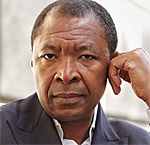
Okwui Enwezor
Blazing new trails in the art world, Okwui Enwezor, born in 1963 in the Nigerian city of Calabar, was the first non-European art director of the documenta. In 1983 Enwezor came to New York City and earned a political science degree from New Jersey City State College. Increasingly fascinated by the world of art, in 1994 he founded Nka: Journal of Contemporary African Art, a magazine that appears three times a year. In 1997 he directed the second Johannesburg Biennale in South Africa, and at the age of just 34 was named artistic director of the documenta 11 in Kassel. Enwezor not only showed the world that there is such a thing as contemporary African art – he also revolutionized the process of exhibiting. He believes in holding public discussions of what should be shown and how, making the discourse a part of the exhibition. In October 2011 he was appointed Director of Haus der Kunst in Munich.





